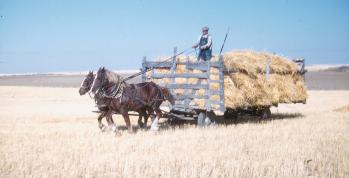
Farming was synonymous with the economic development of Saskatchewan in the early decades of the 20th century. As a result of the national government's land disposal schemes (1872), the building of a transcontinental railroad (completed in 1885), and the 1897 Crow's Nest Pass Agreement establishing low freight rates “in perpetuity,” Saskatchewan was Canada's fastest-growing province during the first three decades of the 20th century: between 1900 and 1930, it boasted 303,000 homestead entries. The territory that became the province of Saskatchewan in 1905 saw its population increase from 91,000 in 1901 to 932,000 in 1936. During this interval the number of farms grew from 13,000 to 142,391; the farm population reached 573,894 in 1936, representing 88% of the rural and 62% of the total population in the province. Communities developed, usually where none had existed before, to serve the agricultural industry and the farm population.

The number of farms in Saskatchewan, as well as the farm population, peaked in 1936. New technologies facilitated the substitution of capital for Labour, expanding farm size and making it possible for fewer farmers to produce the same, or even a growing, volume of output. Between 1936 and 1956, the number of farms declined by about 40,000 and the farm population by about 210,000; average farm size increased by 50%, from 400 to 600 acres.

The continuing decline in the number of farms and farm population has persisted through good times and bad in the agricultural sector, even as some level of diversification from the Wheat economy took hold. New technologies available to farmers led to economies of size and scale in agriculture - the larger the size of the operation, the lower the per unit costs of production. With output prices falling over the long run, and costs of production rising, it was essential to access the most cost-efficient technologies: as the size of operations increased, given a relatively fixed land base, fewer and larger farms were the result. Diversification into livestock has not solved the population decline problem since economies of size were present here too; although the income levels and stability may have been positively affected, the farm population size has not.
The farm population has proven innovative and adaptable, both in terms of their farming operations and their participation in the broader economy. On-farm adjustments have consisted of the adoption of new technologies from mechanization to biotechnology, and the use of the latest information-intensive management and marketing techniques. The extremely narrow margins in most farm production, combined with the lack of producer influence on output prices, have required farmers to continually search for the lowest-cost means of production. Acquiring the newest machinery and equipment, expanding farm size, and participation in the latest Education and training are all ways in which farmers are continually modifying farming operations.
On-farm adaptation has included both specialization and diversification. While the small mixed farm is still present to some degree, production is increasingly concentrated in large-scale specialized farms: 35,000-head feedlots, 5,000-sow hog barns, 17,000-acre grain farms, 1,500-cow-calf operations, 225,000-bird poultry operations, and 500-head dairy farms. These are large, complex and highly specialized businesses requiring major capital investments and sophisticated business skills, but the directly associated employment is relatively minor.
At the other end of the spectrum are relatively small farms where the family is highly dependent on off-farm income. Especially in locations where there is easy access to urban-based employment, it sometimes makes sense to make the farming operation as routine and simple as possible so that substantial (often full-time) participation in other employment is possible. Urban and strong rural communities provide a range of employment opportunities for farm household members in education and health, public administration, and the growing private services sector. Rural areas provide sources of off-farm employment in the form of work in the oil and gas, mining, Transportation, construction, forestry, and rural manufacturing sectors. Farm women participate in off-farm employment at about twice the rate of their male counterparts. As the Rural Population becomes sparser and more widely dispersed, the jobs are fewer and farther away, leading to longer commuting distances. While off-farm employment may consist of a full-time work-day, farm responsibilities are still a major time commitment and responsibility, especially at peak times of the year.
For some farming operations, diversification ventures consist of incorporating new crops and new varieties, often initially on a small scale, as part of the farming operation. In some cases, labour-intensive crops such as herbs and spices are grown for niche markets. Specialty livestock (bison, llamas, elk, angora goats, Vietnamese pigs) is another form of on-farm diversification. Some of these turn out to be no more than a novelty; but others have real long-term commercial value, becoming mainstream enterprises.
Farming is thus very diverse. The 50,598 farms in Saskatchewan reported in the 2001 Census include the large sophisticated businesses, the moderately sized family farms, and the small lifestyle/hobby farms. Farming as the major source of employment comprises about 13% of the provincial labour force. Average farm household income exceeds the average provincial household employment income for all farm size categories: this is the result of creative and varied means of adaptation on the part of farm families - specialization, diversification, expansion, increasing efficiency, off-farm employment, and involvement in non-farm businesses. Close to three-quarters of farm household income is from non-farm sources, illustrating how closely the farming community is integrated into the rest of the provincial economy.
M. Rose Olfert
Print EntryHOME | BROWSE BY SUBJECT | ENTRY LIST (A-Z) | IMAGE INDEX | CONTRIBUTOR INDEX | ABOUT THE ENCYCLOPEDIA | SPONSORS TERMS OF USE | COPYRIGHT © 2006 CANADIAN PLAINS RESEARCH CENTER, UNIVERSITY OF REGINA | POWERED BY MERCURY CMS |
|||
| This web site was produced with financial assistance provided by Western Economic Diversification Canada and the Government of Saskatchewan. |
|||
 |
 |
 |
 |
| Ce site Web a été conçu grâce à l'aide financière de Diversification de l'économie de l'Ouest Canada et le gouvernement de la Saskatchewan. |
|||